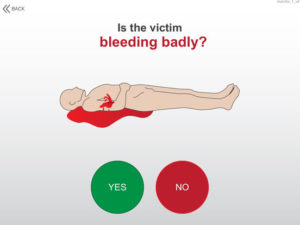
What I have found interesting in watching the footage of shark attacks (few as they might be) is the typical cause of death, exsanguination. Friends and bystanders risk their lives to bring the attack victim to shore but every minute more blood is being lost which can’t be replaced easily. Any decent medic will tell you it’s much better to keep the blood in the body to circulate oxygen than plan on raising pressure with fluids which don’t carry oxygen. Delayed death by organ failure due to poor field perfusion can’t really be called a win.
I can’t advise people to tread water while putting on an improvised tourniquet but it may yield a better outcome than dragging a bled out corpse to the beach. I know the shark could come back to attack again but that seems to be the exception in shark attacks not the rule. Besides, not stopping the bleeding and allowing a limb to continue to bleed just leaves a scent trail for the shark to follow doesn’t it?
Traumatic injuries severe enough to cause loss of life by bleeding out was the most common cause of death in military combat. Data from recent and continuing conflicts have reinforced the role of early application of tourniquets and hemorrhage control when it comes to life saving care and some military units have fantastic survival rates. Non-combat causes of exsanguination include gunshot or stab wounds; motor vehicle crashes; suicide by severing arteries, typically those in the wrists; and partial or total limb amputation due to machinery or motorized cutting devices.
Visitors to my site know that I am a firm believer in giving the lay public more information to better position them to take proper action to save lives. Some of my strategies may be a bit controversial such as my Active Shooter course but if I suffer an injury which is causing me to bleed out, I will gladly take the first trained person who shows up over waiting on the local emergency service providers. Most recently a product has come along that may revolutionize bystander support, the Mobilize Rescue System. I’ll be talking more about this in a future post but it is the first-aid kit of the future as far as I am concerned.
Back to the connection to shark week. In South Africa they have developed what is called a Shark Attack Pack which is designed to give the life guards everything they need to stop bleeding and infuse solutions. I am not sold on the need for fluids in most cases and would be satisfied if first responders along our coastal waters had access to disposable arterial clamps, tourniquets and large trauma dressings. The nice thing about this small list of supplies is that it will work for any cause of severe bleeding, not just a shark attack.
I’m pretty sure that in about two hours I can teach a member of the public what they need to know in order to use these supplies to stop lethal hemorrhaging. I would also include a module on improvised replacements for each item which could probably be rapidly scrounged up. The point is, we can build off of the public’s interest in sharks at this moment in time to educate them on how to manage bleeding regardless of cause. Taking a class, purchasing a tourniquet or placing a Mobilize kit at each life guard tower along beaches anywhere in the world where sharks and human run into each other could save a life down the road.
I’m interested to hear what you think?






Perhaps surfers and swimmers (especially in known Shark birthing and mating areas) should carry a modern CAT tourniquet wherein the surfer/swimmer could apply it themselves–I carry my own on-duty as a paramedic (we regularly get guns displayed to us on calls) and off-duty, as do SEAL team members, and others. If you are going to go into a dangerous environment where you have the possibility of major injury/loss of limb, isn’t it like suicide not to carry a tourniquet? I grew up in the San Francisco side of the Bay Area. Since Great Whites give birth between Monterey Bay (south) and Tomales Bay (north), while I did go out on a fishing boat a couple days a week for a friend’s family deli, I never went swimming in those waters. Why tempt fate!! While I now live and work in the high desert of the Sierra Nevada mountain ranges, I also seem to remember a circular, expandable, container that swimmers and surfers could have handy to keep lower the chances of hypothermia. Why should these people risk medic/lifeguard lives?